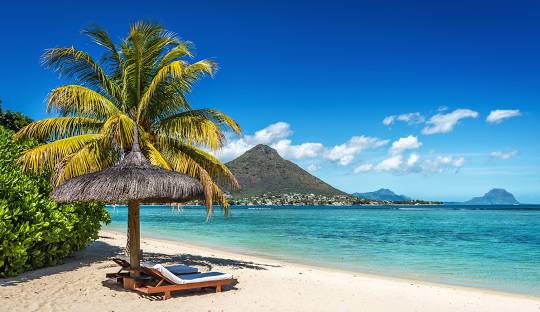Mauritius, East Africa
🏝️ Mauritius: The Jewel of the Indian Ocean
Nestled in the turquoise waters of the Indian Ocean, Mauritius is an idyllic paradise that offers a little bit of everything — from golden beaches and lush mountains to vibrant markets and colonial history. Known for its diverse culture, stunning landscapes, and year-round warm weather, Mauritius is a dream destination for relaxation, adventure, and discovery.
This tropical island is more than just its beaches — it’s a blend of multi-ethnic communities, breathtaking nature, and luxury resorts. Whether you’re seeking adventure, romance, or cultural immersion, Mauritius delivers it all with its vibrant charm and laid-back vibe.
🌊 Beaches of Paradise: Sun, Sand, and Sea
Mauritius is home to some of the world’s most beautiful beaches, characterized by soft white sands, crystal-clear waters, and swaying palm trees.
-
Grand Baie: A popular resort area known for its lively atmosphere, with numerous bars, restaurants, and watersports.
-
Le Morne: Famous for its kite surfing and mountain views, this UNESCO World Heritage site is perfect for both relaxation and adventure.
-
Trou aux Biches: A quieter beach with calm waters, ideal for families and snorkelers looking to explore coral reefs.
-
Blue Bay: A marine park where you can snorkel among vibrant coral reefs, teeming with marine life.
The island’s beaches are some of the most Instagram-worthy spots in the world, making it a perfect destination for beach lovers and water sports enthusiasts.
🏞️ Nature at Its Finest: Mountains, Waterfalls & Hikes
Mauritius is not just about its beaches — the island is filled with breathtaking natural attractions, from mountains and forests to rivers and waterfalls.
-
Black River Gorges National Park: A lush rainforest with hiking trails, waterfalls, and panoramic views of the island. Don’t miss the hike to Alexandra Falls for an incredible view.
-
Chamarel: Famous for the Seven Colored Earths, a unique phenomenon where the sand dunes shift colors. Nearby, you’ll find the Chamarel Waterfall, one of the tallest in Mauritius.
-
Le Morne Brabant: A mountain with cultural and historical significance, it offers one of the best panoramic views on the island. Hiking to the top rewards you with spectacular vistas of the south coast.
-
Pamplemousses Botanical Garden: One of the oldest botanical gardens in the Southern Hemisphere, home to giant water lilies and a variety of exotic plants.
For those who enjoy nature, Mauritius offers a mix of ecotourism and adventure that’s perfect for every type of traveler.
🏙️ Culture and Heritage: A Tapestry of Influences
Mauritius is a melting pot of cultures, combining Indian, Creole, Chinese, and French influences that shape the island’s vibrant heritage.
-
Port Louis: The capital and largest city, where you can explore the Central Market, bustling with vendors selling everything from fresh produce to handmade crafts. Visit the Blue Penny Museum to see historical maritime exhibits and the famous Mauritius Postage Stamp.
-
Aapravasi Ghat: A UNESCO World Heritage site that tells the story of indentured laborers who arrived in Mauritius in the 19th century. It’s a key piece of the island’s history.
-
Mahebourg: A charming town near the southern coast with an intriguing Naval Museum, showcasing Mauritius’ colonial history.
Mauritius’ blend of cultures is reflected in its festivals, religions, and culinary traditions, offering travelers a unique insight into its rich past and modern-day life.
🍽️ Culinary Delights: A Fusion of Flavors
Mauritian cuisine is a melting pot of flavors, blending influences from Indian, Chinese, Creole, and French culinary traditions.
-
Dholl Puri: A beloved street food, this flatbread filled with yellow split peas is often served with curry and chili.
-
Roti: Indian-style bread, commonly stuffed with curry vegetables or chicken, perfect for a quick, savory snack.
-
Fish Vindaye: A tangy, spiced fish curry made with mustard, garlic, and turmeric — an authentic Creole dish.
-
Gâteaux Piment: Mauritius’ version of chili fritters, a spicy snack often eaten as an appetizer or snack on the go.
Mauritius is also known for its rum distilleries, and a tour of a local rum factory, such as Rhumerie de Chamarel, is a great way to sample the island’s specialty spirits.
🛏️ Accommodation: From Luxury to Local Charm
Mauritius offers a wide variety of accommodations, ranging from luxury resorts to quaint guesthouses and eco-lodges.
-
Luxury Resorts: Areas like Belle Mare and Flic en Flac are home to some of the island’s top resorts, including One&Only Le Saint Géran and The St. Regis — perfect for those seeking indulgence.
-
Boutique Hotels: Smaller, locally-run hotels offer a more intimate experience, with a chance to stay closer to nature and culture.
-
Eco-Lodges: Sustainable stays such as Lakaz Chamarel offer an eco-conscious way to enjoy Mauritius’ beauty while supporting local communities and the environment.
Many resorts also offer all-inclusive packages, which include meals, drinks, and excursions, ensuring a relaxing and seamless experience.
🧳 Tips for Visiting Mauritius
-
Best Time to Visit: The ideal time to visit is during the winter months (May–Dec), when the weather is cooler and drier. The summer months (Jan–Apr) are warmer and wetter, but also less crowded.
-
Currency: The local currency is the Mauritian Rupee (MUR), but major credit cards are widely accepted, and ATMs are available in cities and resorts.
-
Language: The official language is English, but most people speak French and Mauritian Creole. English is widely understood, especially in tourist areas.


